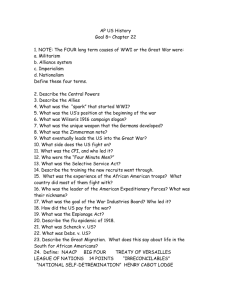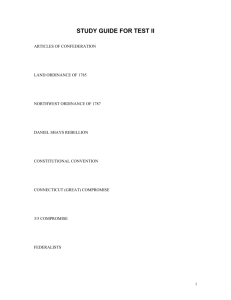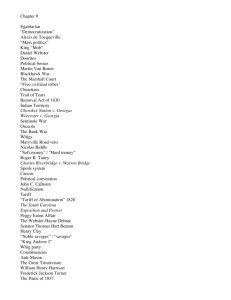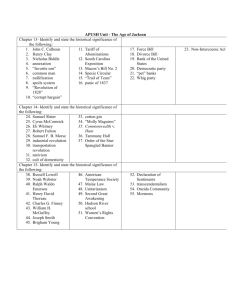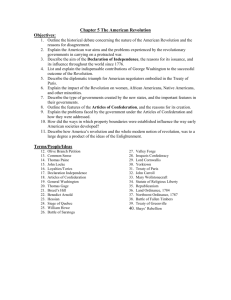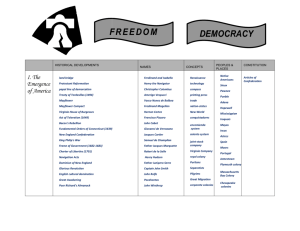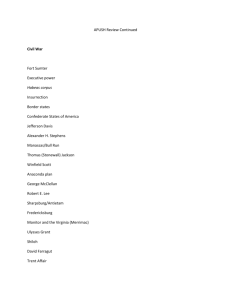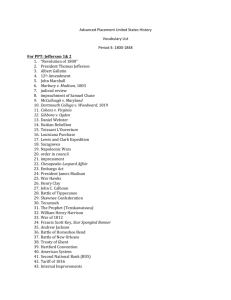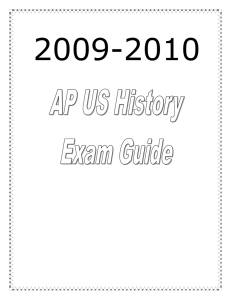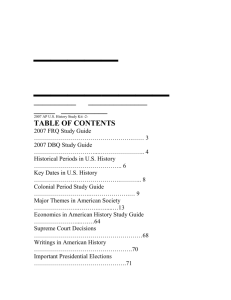Nationalism & Democracy Exam Prep (1800-1848)
advertisement
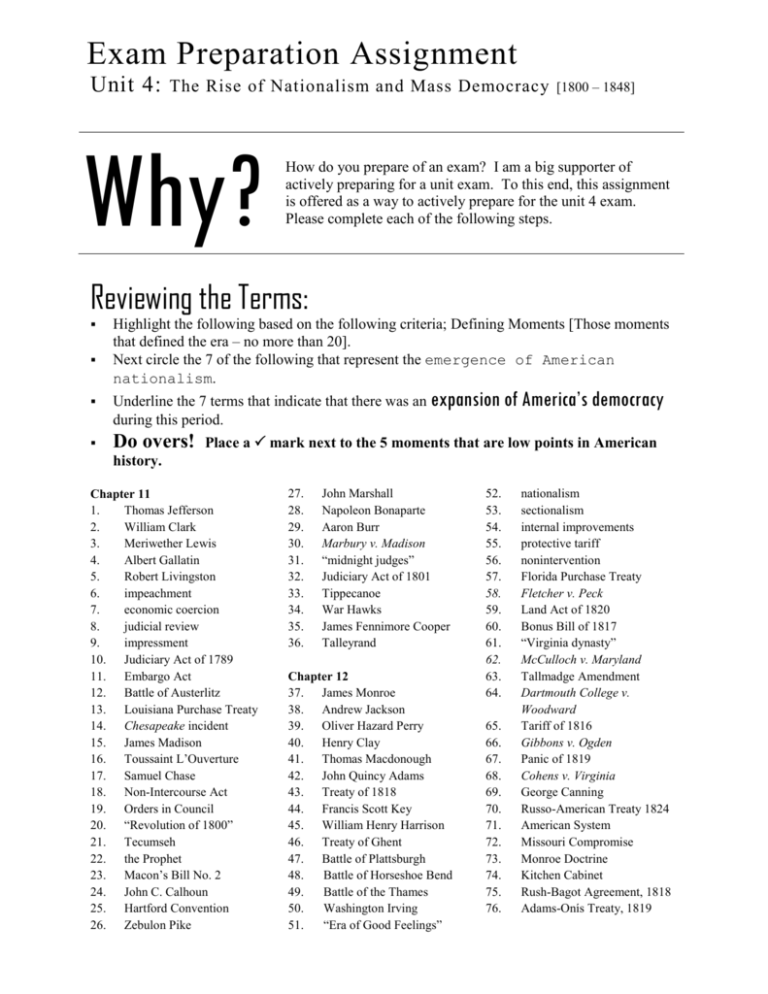
Exam Preparation Assignment Unit 4: The Rise of Nationalism and Mass Democracy Why? [1800 – 1848] How do you prepare of an exam? I am a big supporter of actively preparing for a unit exam. To this end, this assignment is offered as a way to actively prepare for the unit 4 exam. Please complete each of the following steps. Reviewing the Terms: Highlight the following based on the following criteria; Defining Moments [Those moments that defined the era – no more than 20]. Next circle the 7 of the following that represent the emergence of American nationalism. Underline the 7 terms that indicate that there was an expansion of America’s democracy during this period. Do overs! Place a mark next to the 5 moments that are low points in American history. Chapter 11 1. Thomas Jefferson 2. William Clark 3. Meriwether Lewis 4. Albert Gallatin 5. Robert Livingston 6. impeachment 7. economic coercion 8. judicial review 9. impressment 10. Judiciary Act of 1789 11. Embargo Act 12. Battle of Austerlitz 13. Louisiana Purchase Treaty 14. Chesapeake incident 15. James Madison 16. Toussaint L’Ouverture 17. Samuel Chase 18. Non-Intercourse Act 19. Orders in Council 20. “Revolution of 1800” 21. Tecumseh 22. the Prophet 23. Macon’s Bill No. 2 24. John C. Calhoun 25. Hartford Convention 26. Zebulon Pike 27. 28. 29. 30. 31. 32. 33. 34. 35. 36. John Marshall Napoleon Bonaparte Aaron Burr Marbury v. Madison “midnight judges” Judiciary Act of 1801 Tippecanoe War Hawks James Fennimore Cooper Talleyrand Chapter 12 37. James Monroe 38. Andrew Jackson 39. Oliver Hazard Perry 40. Henry Clay 41. Thomas Macdonough 42. John Quincy Adams 43. Treaty of 1818 44. Francis Scott Key 45. William Henry Harrison 46. Treaty of Ghent 47. Battle of Plattsburgh 48. Battle of Horseshoe Bend 49. Battle of the Thames 50. Washington Irving 51. “Era of Good Feelings” 52. 53. 54. 55. 56. 57. 58. 59. 60. 61. 62. 63. 64. 65. 66. 67. 68. 69. 70. 71. 72. 73. 74. 75. 76. nationalism sectionalism internal improvements protective tariff nonintervention Florida Purchase Treaty Fletcher v. Peck Land Act of 1820 Bonus Bill of 1817 “Virginia dynasty” McCulloch v. Maryland Tallmadge Amendment Dartmouth College v. Woodward Tariff of 1816 Gibbons v. Ogden Panic of 1819 Cohens v. Virginia George Canning Russo-American Treaty 1824 American System Missouri Compromise Monroe Doctrine Kitchen Cabinet Rush-Bagot Agreement, 1818 Adams-Onís Treaty, 1819 Chapter 13 77. “Revolution of 1828” 78. common man 79. Andrew Jackson 80. William Crawford 81. Daniel Webster 82. John C. Calhoun 83. Denmark Vesey 84. Davy Crockett 85. Henry Clay 86. John Quincy Adams 87. Robert Y. Hayne 88. Martin Van Buren 89. tyranny of the majority 90. William Henry Harrison 91. rotation in office 92. New Democracy 93. spoils system 94. Maysville Road 95. nullification 96. Twelfth Amendment 97. Tariff of Abominations (1828) 98. National Republicans 99. Democratic party 100. Peggy Eaton affair 101. Anti-Masonic party 102. “corrupt bargain” 103. South Carolina Exposition 104. Nicholas Biddle 105. Osceola 106. Santa Anna 107. Martin Van Buren 108. Sam Houston 109. Stephen Austin 110. “Texican” and Tejanos 111. Whig party 112. Black Hawk 113. Tariff of 1833 114. Force Bill 115. 2nd Bank of the United States 116. Specie Circular 117. “wildcat” banks 118. Independent Treasury Log “pet” banks 119. Divorce Bill 120. Cabin/Hard Cider 121. Two Party System 122. “Trail of Tears” 123. Worcester v. Georgia 124. Cherokees 125. Seminole Indians 126. 127. Bureau of Indian Affairs Lone Star Republic Chapter 14 128. Harriet Beecher Stowe 129. Cotton Kingdom 130. James Fennimore Cooper 131. Samuel Slater 132. Lowell system 133. Carl Schurz 134. DeWitt Clinton 135. Cyrus McCormick 136. Robert Fulton 137. Catherine Beecher 138. Eli Whitney 139. cotton gin 140. Samuel F. B. Morse 141. John Deere 142. Moses Brown 143. Order of the Star Spangled Banner 144. American “Know-Nothing” Party 145. industrial revolution 146. “wage slaves” 147. transportation revolution 148. Erie Canal 149. Cumberland Road 150. Railroads 151. Pony Express 152. the “trails” west 153. Charles River Bridge 154. Mark Twain 155. George Catlin 156. Panic of 1837 157. “cult of domesticity” 158. nativism 159. Anabaptist 160. Amish 161. Germans 162. Irish 163. “Molly Maguires” 164. Tammany Hall 165. “March of Millions” 166. Knickerbocker group 167. Dewitt Clinton 168. Samuel F.B. Morse 169. Eli Whitney Chapter 15 170. 171. 172. 173. 174. 175. 176. 177. 178. 179. 180. 181. 182. 183. 184. 185. 186. 187. 188. 189. 190. 191. 192. 193. 194. 195. 196. 197. 198. 199. 200. 201. 202. 203. 204. 205. 206. 207. 208. 209. 210. 211. 212. 213. 214. 215. 216. 217. 218. 219. 220. Charles G. Finney Second Great Awakening Burned-Over District Deism Millerites Mormons Joseph Smith Brigham Young Unitarianism Hudson Bay Company John J. Audubon Neal S. Dow gag resolution Robert Owen William Gilmore Simms Horace Mann William H. McGuffey Peter Cartwright Noah Webster Emma Willard Elizabeth Cady Stanton Susan B. Anthony Lucretia Mott Margaret Fuller Louis Agassiz Hudson River School Art American Temperance Society Shakers Women’s Rights Convention Oberlin College Maine Law Brook Farm Oneida Community Dorthea Dix William Cullen Bryant Walt Whitman Stephen Foster James Fennimore Cooper Washington Irving Knickerbocker group Henry Wadsworth Longfellow Transcendentalism Henry David Thoreau John Greenleaf Whittier James Russell Lowell Oliver Wendell Holmes Louisa May Alcott Emily Dickinson Edgar Allan Poe Nathaniel Hawthorne Herman Melville Big Ideas 1. Provide evidence in support of each of the following themes. peaceful transfer of power from one party to another [i.e. Revolution of 1800] short and long-term consequences of the Louisiana Purchase and Jeffersonian foreign policy changes in and developments of Party Positions and the emergence of the 2nd American party system causes and consequences of the War of 1812 and expansion and the growth of Nationalism examination of the Supreme Court, judicial review, and strict v. loose constructionists emergence of the “Common Man” and the expansion of democracy reform movements, religious developments, and the changing American character Industrial [or Market] Revolution comes to America spurred by innovations in communication, manufacturing, and transportation rise of Sectionalism in the wake of geographic and economic expansion. 2. Was America during this era better defined by its leadership (presidents), its economy or its demographics? 3. Which of the following labels does the most effective job of describing the respective event? “tariff of abominations” The“Age of Reform” “Cult of Domesticity and True Womanhood” “Jacksonian Revolution of 1828” Second Great Awakening Era of Good Feelings Know-Nothings “corrupt bargain” American System For each of the following lists, be sure to provide specific historical evidence to support your selections. 4. Rank the 5 most significant events, people, movements, etc. that contributed to creating a national identity. 5. Rank the 5 most significant actions, events, etc. that impacted the conditions of Native Americans. 6. Rank the 5 most significant economic events. This includes innovations that would impact the economy. 7. Rank the 5 most important foreign policy events. 8. Rank the 10 most important people (no presidents) from this era.
